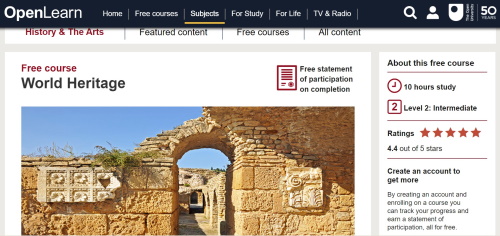Blog WHS website
A free course in World Heritage
I am a fan of the Open University concept, where you can study a random subject at a high level whenever and from where it suits you. I even finished a Bachelor’s degree in Art History a few years ago at the Dutch Open University. One of the subjects in that curriculum was a disappointing introduction to Heritage management (I wrote a post about it in 2015). Last week I noticed that the UK’s Open University has a free course on my favourite subject of all: World Heritage. The course material gives an overview of what UNESCO’s World Heritage is about. Also it provides 5 case studies on specific WHS: New Lanark, Bath, Edinburgh, Lake District and Tarragona.

The course is equivalent to 10 hours of study. I clicked through it in some 45 minutes – the introductions about World Heritage, UNESCO, its procedures etc. were of course already well-known by me. I was more interested in the case studies.
New Lanark is presented as “an enormous success and [it] has gained many plaudits and awards for the long-term commitment of its trust and management to restoration”. After the factory closed in 1968, restoration already started 5 years later with the establishment of the New Lanark Conservation Trust. It went on a long track to inscription: it was brought forward first in 1986 and got inscribed in 2001. Looking back, “Revitalisation has had a major impact on the local community and region”. Although by some a nomination of industrial heritage like this is seen as “a response to misplaced nostalgia for working-class life in communities undergoing rapid change ..”.
There’s an interesting 14 minute audio file included about the preparation of the Lake District bid. Although already well-known in the UK, global recognition was still wanted. It had twice failed in the late 1980s, but now they were trying again and knew they had to deliver a special story. It was ‘saved’ by the establishment of the cultural landscape category in 1992, where it fits in better. ICOMOS UK even claims that the Lake District failures were instrumental in recognizing cultural landscapes as a separate category. What the proposal team also learned is that beauty in itself isn’t enough, you have to point at something under threat: here they found it with the disappearing hill farms. Representatives in the travel business were skeptical of getting additional red tape to deal with after inscription, but also hoped that the tourists were to stay a few days longer and be more interested in the culture and environment.

The information delivered in the course is mostly based on facts (I found no errors, which are so common in discussions about World Heritage). Only some subjective interpretation shines through. I was perplexed for example over this conclusion: “World Heritage has its own vocabulary, using the discourse of international diplomacy. Much of its documentation, originating in French, takes on a mid-Atlantic flavour in English, something readily appreciated from the numerous websites dedicated to the subject.” The last sentence alone makes me wonder about 3 things:
- There’s a hint there that documentation in French is somehow ‘odd’. And I sense some bewilderment too, maybe because WH is a rare area where there’s no UK/US dominance?
- “takes on a mid-Atlantic flavour in English” – what does mid-Atlantic mean in this sentence, native English speakers can you help me out here? I guess it’s not about the Azores… Google directs me to the Mid-Atlantic states—Pennsylvania, New Jersey, New York, and Delaware. Huh?
- And those “numerous websites” – do they include ours? I am surely aware that with the WH comes a whole vocabulary which we all use in our reviews and forum posts, I even added a glossary.

The course is at its most informative when the UK sites and policies are discussed. For example how the UK selection process works (mostly decentralized among its constituent countries England, Scotland, Wales and Northern Ireland). However “It is unclear how the list of sites in overseas territories was arrived at”. Unfortunately the content of the course all stays quite superficial. But it still is worth an hour or so of your time as a WH aficionado.
Els - 8 December 2019
Comments
Solivagant 8 December 2019
Am on road at the moment with small keyboard and big fingers so can't write much. But "Mid Atlantic as used in UK has absolutely nothing to do with Mid Atlantic states as in US. It refers to the use of an English language which adopts some "Americanisms" in words, style and, if spoken, in accent. Churchill said that umUS/UK were 2 countries divided by 1 language and a native English speaker us very aware of differences. "Managerial speak" will be one area and may be what the WHS article was referring to. Of course with contemporary media etc "English English" is less and less commonly adopted!
Els Slots 8 December 2019
Thanks Alexander and Jay. From across the ocean (UK-side) meltwaterfalls reports that it sounds like the accent used by Frasier in the eponymous comedy series.
Alexander Parsons 8 December 2019
'Mid-Atlantic' or 'transatlantic' is basically a pretentious way of speaking that was popular amongst the rich decades ago.
https://en.wikipedia.org/wiki/Mid-Atlantic_accent
Jay T 8 December 2019
As a mid-Atlantic resident in the US, I doubt he’s referring directly to any of our states, but rather to the style of international English employed at the UN and in Washington.
I’m not sure it’s an exact parallel, but I’m reminded of how newscasters in the US train to speak in a midwestern accent, which is most commonly understood by Americans.